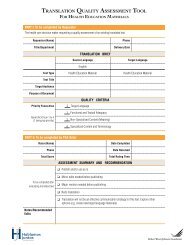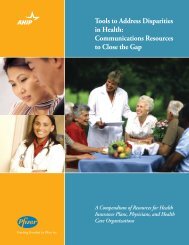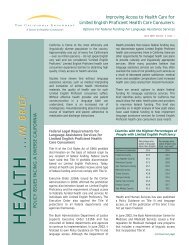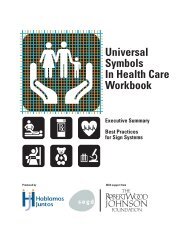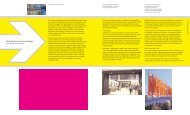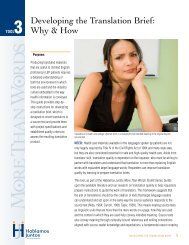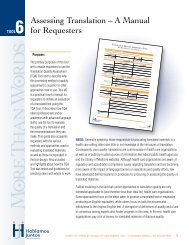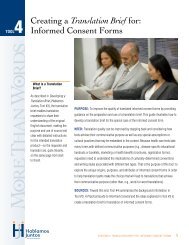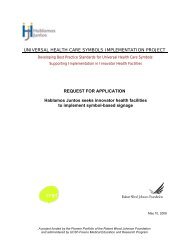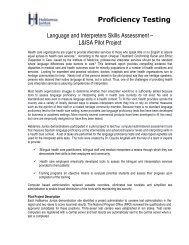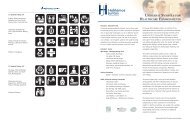Language Use and English-Speaking Ability: 2000 - Census Bureau
Language Use and English-Speaking Ability: 2000 - Census Bureau
Language Use and English-Speaking Ability: 2000 - Census Bureau
You also want an ePaper? Increase the reach of your titles
YUMPU automatically turns print PDFs into web optimized ePapers that Google loves.
about 380 categories of single languages<br />
or language families. 2<br />
For people who answered “Yes” to<br />
Question 11a, Question 11c asked<br />
respondents to indicate how well<br />
they spoke <strong>English</strong>. Respondents<br />
who said they spoke <strong>English</strong> “Very<br />
well” were considered to have no<br />
difficulty with <strong>English</strong>. Those who<br />
indicated they spoke <strong>English</strong> “Well,”<br />
“Not well,” or “Not at all” were considered<br />
to have difficulty with<br />
<strong>English</strong> — identified also as people<br />
who spoke <strong>English</strong> less than<br />
“Very well.”<br />
The number <strong>and</strong> percentage<br />
of people in the United States<br />
who spoke a language other<br />
than <strong>English</strong> at home increased<br />
between 1990 <strong>and</strong> <strong>2000</strong>.<br />
In <strong>2000</strong>, 18 percent of the total<br />
population aged 5 <strong>and</strong> over, or<br />
47.0 million people, reported they<br />
spoke a language other than<br />
<strong>English</strong> at home. 3 These figures<br />
were up from 14 percent (31.8 million)<br />
in 1990 <strong>and</strong> 11 percent<br />
(23.1 million) in 1980. The number<br />
of people who spoke a language<br />
other than <strong>English</strong> at home grew by<br />
38 percent in the 1980s <strong>and</strong> by<br />
47 percent in the 1990s. While the<br />
population aged 5 <strong>and</strong> over grew<br />
by one-fourth from 1980 to <strong>2000</strong>,<br />
the number who spoke a language<br />
other than <strong>English</strong> at home more<br />
than doubled.<br />
In <strong>2000</strong>, most people who spoke a<br />
language other than <strong>English</strong> at<br />
home reported they spoke <strong>English</strong><br />
“Very well” (55 percent or<br />
Figure 2.<br />
Speakers of <strong>Language</strong>s Other Than <strong>English</strong> at Home<br />
<strong>and</strong> <strong>English</strong> <strong>Ability</strong> by <strong>Language</strong> Group: <strong>2000</strong><br />
(Population 5 years <strong>and</strong> over, in millions. Data based on sample. For<br />
information on confidentiality protection, nonsampling error, sampling<br />
error, <strong>and</strong> definitions, see www.census.gov/prod/cen<strong>2000</strong>/doc/sf3.pdf)<br />
Other Indo-European<br />
languages<br />
Asian <strong>and</strong> Pacific<br />
Isl<strong>and</strong> languages<br />
Spanish 14.3<br />
All other<br />
languages<br />
3.4<br />
6.6<br />
3.6<br />
1.3 0.6 1.9<br />
3.4<br />
7.0<br />
Source: U.S. <strong>Census</strong> <strong>Bureau</strong>, <strong>Census</strong> <strong>2000</strong> Summary File 3.<br />
Spoke <strong>English</strong> "Very well"<br />
Spoke <strong>English</strong> less than "Very well"<br />
10.0<br />
13.8<br />
Figure 3.<br />
Ten <strong>Language</strong>s Most Frequently Spoken at Home<br />
Other Than <strong>English</strong> <strong>and</strong> Spanish: <strong>2000</strong><br />
(Population 5 years <strong>and</strong> over, in millions. Data based on sample. For<br />
information on confidentiality protection, nonsampling error, sampling<br />
error, <strong>and</strong> definitions, see www.census.gov/prod/cen<strong>2000</strong>/doc/sf3.pdf)<br />
Chinese<br />
French<br />
German<br />
Tagalog<br />
Vietnamese 1<br />
Italian 1<br />
Korean<br />
Russian<br />
0.7<br />
0.9<br />
1.0<br />
1.0<br />
1.2<br />
1.4<br />
1.6<br />
2.0<br />
28.1<br />
2<br />
More detailed information on languages<br />
<strong>and</strong> language coding can be found in<br />
“Summary File 3: <strong>2000</strong> <strong>Census</strong> of Population<br />
<strong>and</strong> Housing Technical Documentation” issued<br />
December 2002 (www.census.gov/prod<br />
/cen<strong>2000</strong>/doc/sf3.pdf).<br />
3<br />
The estimates in this report are based on<br />
responses from a sample of the population.<br />
As with all surveys, estimates may vary from<br />
the actual values because of sampling variation<br />
or other factors. All statements made in<br />
this report have undergone statistical testing<br />
<strong>and</strong> are significant at the 90-percent confidence<br />
level unless otherwise noted.<br />
Polish<br />
Arabic<br />
0.6<br />
0.7<br />
1 The number of Vietnamese speakers <strong>and</strong> the number of Italian speakers were not<br />
statistically different from one another.<br />
Note: The estimates in this figure vary from actual values due to sampling errors. As<br />
a result, the number of speakers of some languages shown in this figure may not be<br />
statistically different from the number of speakers of languages not shown in this figure.<br />
Source: U.S. <strong>Census</strong> <strong>Bureau</strong>, <strong>Census</strong> <strong>2000</strong> Summary File 3.<br />
2 U.S. <strong>Census</strong> <strong>Bureau</strong>



